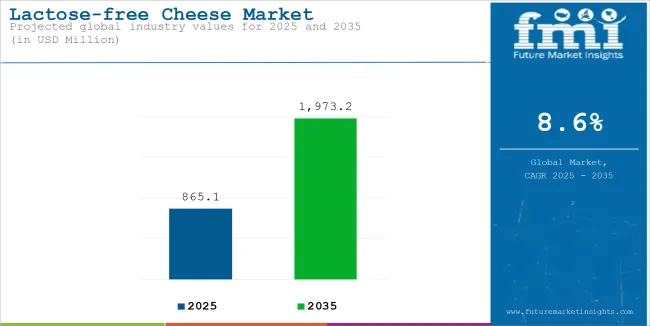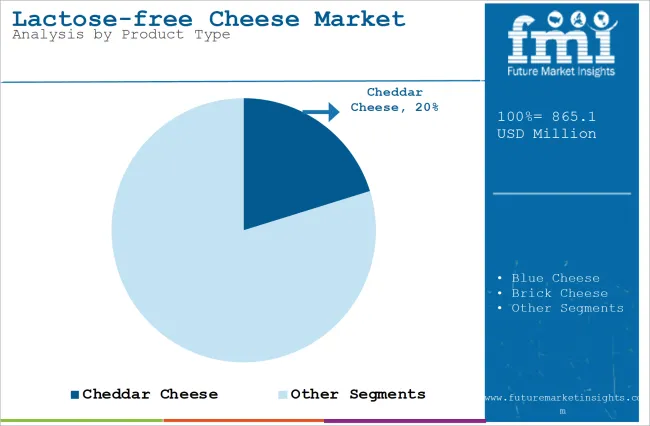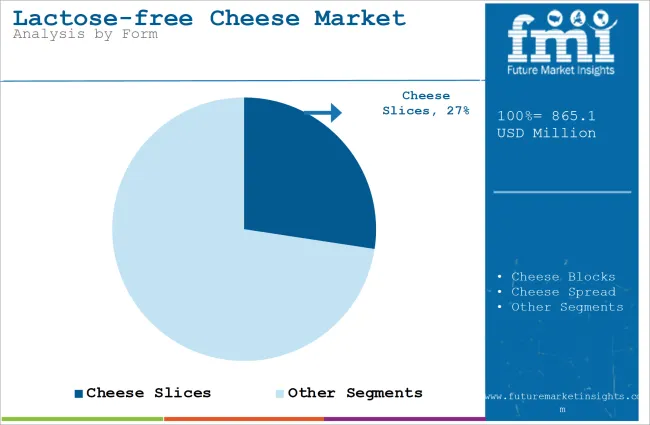The global Lactose-free Cheese industry is estimated to be worth USD 865.1 million by 2025. It is projected to reach USD 1,973.2 million by 2035, reflecting a CAGR of 8.6% over the assessment period 2025 to 2035.
The Lactose-free Cheese’ market's growth is anticipated to be attributed to its widespread usage in the food & beverage industry, where it aids in moisture absorption, keeps the product's free-flow texture, and organoleptic qualities, thus extending its shelf life. It's also utilized in other industries like animal feed, where increased demand for high-quality feed and an expansion in the number of feed additives, particularly in the compound feed industry, have been significant growth drivers of the market.
This was owing to its application in various end-use industries ranging from food & beverage, animal feed to fertilizers where it is used to prevent the lumping of powder form of products by creating a water-repelling layer of dust particles and absorbing the excess moisture.
However, in recent years, multiple types of research have hinted that these Lactose-free Cheese possibly have adverse side effects on the food where they end up degrading the nutritional qualities of vitamin C. Additionally, natural Lactose-free Cheese such as magnesium carbonate and calcium carbonate, which are in higher demand among the consumer due to rising awareness of using organic and natural ingredients in food consumed, are relatively costlier as compared to synthetic Lactose-free Cheese which are easily available.

| Attributes | Description |
|---|---|
| Estimated Global Lactose-free Cheese Industry Size (2025E) | USD 865.1 million |
| Projected Global Lactose-free Cheese Industry Value (2035F) | USD 1,973.2 million |
| Value-based CAGR (2025 to 2035) | 8.6% |
The below table presents a comparative assessment of the variation in CAGR over six months for the base year (2023) and current year (2024) for the global Lactose-free Cheese market. This analysis reveals crucial shifts in performance and indicates revenue realization patterns, thus providing stakeholders with a better vision of the growth trajectory over the year. The first half of the year, or H1, spans from January to June. The second half, H2, includes the months from July to December.
| Particular | Value CAGR |
|---|---|
| H1 | 7.9% (2024 to 2034) |
| H2 | 8.0% (2024 to 2034) |
| H1 | 8.2% (2025 to 2035) |
| H2 | 8.3% (2025 to 2035) |
In the first half (H1) of the decade from 2025 to 2035, the business is predicted to surge at a CAGR of 7.9%, followed by a higher growth rate of 8.0% in the second half (H2) of the same decade. Moving into the subsequent period, from H1 2024 to H2 2034, the CAGR is projected to increase to 8.2% in the first half and remain considerably high at 8.3% in the second half. In the first half (H1) the sector witnessed an increase of 10 BPS while in the second half (H2), the business witnessed a decrease of 5 BPS.
Growing Prevalence of Lactose Intolerance Augmenting the Lactose-free Cheese Market
The rising lactose-intolerance population is one of the major factors driving the growth of the lactose-free cheese market globally, with increasing numbers of individuals reporting symptoms and consequently product development. People with lactose intolerance, a condition where the body cannot break down lactamine in milk and dairy products owing to dietary restrictions, affect many parts of the world.
Approximately two-thirds of all adults worldwide are estimated to have a reduced capacity to digest lactose after infancy, although the prevalence rates vary widely across different regions globally. The high prevalence has led to a strong demand for alternatives to traditional dairy products, with cheese being regarded as essential in many cultures. Diagnostic technologies and substantial health education have made it easier to identify lactose intolerance symptoms such as bloating, diarrhea, and stomach pain.
The surge in understanding has driven consumers to be more inclined to purchase specialty products that cater to their dietary preferences. The food industry has focused on investing heavily in lactose-free cheese alternatives, which employ enzyme treatments to eliminate or break down the lactogenic agent present in milk. Hence, the resulting products are designed to have the same taste and texture as regular cheese but are also lactose-tolerant.
Enhanced Product Varieties and Gourmet Offerings Impelling Market Growth
Producers are extending their range of lactose-free cheese beyond well-known brands in response to changing consumer preferences. This trend has helped turn lactose-free cheese into a well-known, rather than a niche product, which targets not only individuals who are intolerance sufferers but also those who look for premium dairy products.
The development of lactose-free cheddar and mozzarella is one step, and the development of brie, blue, and gouda cheese and demonstrates the possibility of the industry to satisfy different consumers.
The characteristics of taste, texture, and the intricate stage of production of any dairy cheese have always been regarded as high quality. These characteristics are the limited inclusion of lactose-free options, enabling manufacturers to reach out to an audience of foodie and artisan product consumers.
In the era of veganism, manufacturers are experimenting with cheese that contains coconut, almond, and cashew. This has also encouraged lactose-free cheese to gain more acceptance which shows how one can still indulge in quality and tasty food with dietary restrictions.
Innovation in Functional and Nutritional Profiles Shapes the Market
The potential for innovation in the functional and nutritional characteristics of lactose-free cheese offers an essential growth opportunity, driven by consumer demand for health-conscious and value-added food products.
Holistic wellness is the primary focus of modern dietary trends, which indicates that individuals seek products that not only satisfy their calorie requirements but also offer health benefits beyond them. The evolution of this trend has prompted manufacturers of lactose-free cheese to move away from basic formulations and towards more inventive methods to enhance the nutritional value and functionality of their products.
With the introduction of probiotics, fortified vitamins and minerals, and optimized macronutrient compositions to replace lactose-containing cheese, it is becoming a popular choice among consumers who value their health benefits. There are two main advantages for lactose-free products when probiotics are added into the mix, these probiotic enriched lactose foods can various dietary options targeting a health-conscious audience.
Furthermore, the addition of prebiotics, which provides nourishment for probiotics, increases the appeal of such products by fostering a symbiotic effect that optimizes gut health, addressing the digestive concerns of lactose-intolerant individuals while actively promoting digestive wellness.
Global sales increased at a CAGR of 8.0% from 2020 to 2024. For the next ten years (2025 to 2035), projections are that expenditure on such products will rise at 8.6% CAGR.
Between 2019 to 2023 increasing concern over sustainability measures in development of biodegradable Lactose-free Cheese. It also emphasis on eco-friendly production materials and process. Alpro UK Ltd., Amy's Kitchen, Inc., and Arla Foods Amba companies are competing not just on the basis of product quality, but also on strategic movements to gain the maximum market share.
From the year 2025 to 2035, the health and wellness movement is changing consumer preferences, as consumers seek healthier alternatives, manufacturers respond by reformulating their products with cleaner labels that appeal to health-conscious customers.
This trend has led to innovation in lactose-free cheese, with a greater emphasis on cheese alternatives. For lactose intolerant people, it is not necessary to completely avoid dairy products' indulgence and nutritional value. Thus, the lactose-free dairy market is the fastest-growing segment in the dairy industry.
Tier 1 Companies are referred to as the major players of the industry as they are fully established worldwide with majority shares of the business ecosystem. Industry leaders always lead the level of creativity, research, and development and most of the time are the trendsetters. The companies are concentrating on the lactose-free cheese free of artificial additives are gaining popularity as manufacturers strive to meet consumer demand for healthier, more trustworthy products.
Tier 2 Companies are the regional players with adequate market coverage and are known for offering niche products. They are typically more localized and tailoring products to local consumer requirements makes them competitive.
Tier 3 Companies are smaller players who are usually limited to the local or regional areas. They tend to service localized areas and do not possess the same level of R&D as bigger companies but are nonetheless helpful in satisfying local requirements. These companies are smaller in size but still remain strong in their target industries owing to their deep-rooted innovations and customer service. Also, these companies emphasize traditional methods, techniques, artisanal production or unique product offerings.
The following table shows the estimated growth rates of the top three territories. China and Japan are set to exhibit high consumption, recording CAGRs of 6.2% and 7.1%, respectively, through 2034.
| Countries | CAGR 2025 to 2035 |
|---|---|
| The USA | 5.6% |
| Brazil | 5.1% |
| India | 9.6% |
| Japan | 7.1% |
| China | 6.2% |
A significant increase in lactose-free cheese sales is propelling the USA market towards 2024. The surge is largely due to consumers' growing awareness of their health and dietary requirements. With a majority of individuals diagnosed with lactose intolerance, is presently heightened demand for dairy products that promote gut health while maintaining their quality and flavor. Many consumers are finding ways to enjoy conventional cheese-based meals without the addition of lactose-containing cheese, making it a convenient alternative.
Furthermore, the shift toward healthier eating habits has expanded the market for lactose-free cheese to include individuals consume other types of dairy products. Americans are increasingly opting to consume cleaner, natural, and readily digested foods because of the health benefits they offer.
To accommodate this demand, food service companies and retailers in the USA are gradually introducing lactose-free cheese into their products. This move emphasizes how customer tastes are transforming the dairy market, with lactose-free cheese playing a vital role in addressing the rising requirements of health-conscious customers.
Lactose-free cheese sales are predicted to skyrocket in the United Kingdom by 2024, driven by customers' increased preference for plant-based and specialist diets. With a growing awareness of lactose intolerance, many customers are actively looking for dairy alternatives that meet their nutritional demands while maintaining product quality.
The increasing adoption of flexitarian lifestyle is offering an additional avenue, as many of the options in lactose-free cheese are being diversified with plant-based formulations aimed at these consumer groups.
UK manufacturers have responded to this demand by broadening the range of superior-quality lactose-free cheese alternatives, including novel and numerous flavors and textures for conventional as well as gourmet tastes. Meanwhile, increasing visibility in mainstream retail channels broadens access contributing to their widespread adoption.

| Segment | Cheddar Cheese (By product Type) |
|---|---|
| Value Share (2024) | 20.2% |
Based on the product type, cheddar cheese is anticipate to dominate the global lactose-free cheese market during the forecast period. Its dominance can be attributed to its widespread popularity, versatile applications, and significant cultural relevance across globe. Cheddar cheese is commonly applied in food service and home cooking, particularly as a major ingredient in a wide variety of dishes, including sandwiches, pastries, sauces, and burgers.
Lactose-free cheddar cheese maintains the characteristic flavor quality, consistency, and firm texture. It therefore becomes the preferred type of cheese by the consumers’ who are mostly intolerant to lactose, but want to enjoy their meals without compromising quality or taste. Besides, lactose-free cheddar can be found in a wide variety of formats including shredded, blocks, slices, and grated forms to suit different customer segments.
Producers direct considerable investments toward the texture and taste development of the lactose-free cheddar cheese to be at par with sensory qualities of standard cheddar. Its applicability to different types of meals and cooking traditions, in addition to the high consumer demand, re-establishes cheddar as the most important product within the lactose-free cheese market.

| Segment | Cheese Slices (By Form) |
|---|---|
| Value Share (2024) | 27.4% |
Lactose-free cheese slices are one of the most popular product form in the global market, owing to its unparalleled adaptability and ease, which adapts to modern consumers changing individuals. This format is very popular as it is ready to use without the need for slicing or portioning. As a result, cheese slices are an excellent alternative for quick snacks and dinners. They blend perfectly into ordinary meals like sandwiches, burgers, and wraps, allowing customers to enjoy their favorite meals without concern about digestive discomfort.
The popularity of cheese slices is further enhanced by their appeal to both individual households and the food service industry. For households, pre-packaged slices offer controlled portions and reduced waste. In the food service sector, they simplify operations by ensuring uniformity and ease of handling. Additionally, compact and stackable packaging of lactose-free cheese slices enhances portability, making them a convenient option for packed lunches and on-the-go consumption.
The competition landscape of the lactose-free cheese market is intense. Arla Foods Amba, UK Ltd., and Amy's Kitchen, Inc., among others are some of the major market players and contribute significantly in terms of research & development investment as well as further towards the creation premium-quality lactose-free cheese. Such companies also seek to multiply the investment that they can dedicate to the efficient manufacturing of developing innovative products to maintain product quality, growth rates, as well as its efficiency.
For instance:
General Mills, Inc. is an American company that produces and markets branded consumer goods for sale in retail establishments. The company's ‘accelerate’ strategy directs how it builds brands, innovates nonstop, scales up, and stands up for what's right in the world. A few of its well-known trademarks in its portfolio are Cheerios, Nature Valley, Blue Buffalo, Häagen-Dazs, Old El Paso, Pillsbury, Betty Crocker, Yoplait, Annie's, Wanchai Ferry, Yoki, and others.
Arla Foods Amba, on the other hand, is a Danish-Swedish multinational cooperative with headquarters in Viby, Denmark. It is the biggest dairy firm in the UK, as well as the largest producer of dairy products in Scandinavia. The Swedish dairy cooperative Arla and the Danish dairy business MD Foods merged on April 17, 2000, to create Arla Foods. According to milk volume, Arla Foods is the fourth-largest dairy firm in the world and seventh in terms of revenue.
As per Product Type, the industry has been categorized into Blue Cheese, Brick Cheese, Camembert Cheese, Cheddar Cheese, Cottage Cheese, Mozzarella Cheese, and Others.
As per Form, the industry has been categorized into Cheese Blocks, Cheese Slice, Cheese Spread, Triangle, and Others.
This segment is further categorized into Business to Business and Business to Consumer.
Industry analysis has been carried out in key countries of North America, Latin America, Western Europe, Eastern Europe, East Asia, South Asia & Pacific, Central Asia, Russia and Belarus, Balkan & Baltics, and the Middle East & Africa.
The global industry is estimated at a value of USD 865.1 million in 2025.
Sales increased at 8.0% CAGR between 2020 and 2024.
Some of the leaders in this industry include General Mills, Alpro UK Ltd., Amy's Kitchen, Inc., Arla Foods Amba, Violife (Flora Food Group), Prairie Farms Dairy, Miyoko’s Creamery, Field Roast, Treeline Cheese, Kite Hill, Daiya Foods, Inc., and Cabot Creamery, among others.
The North America territory is projected to hold a revenue share of 32.4% over the forecast period.
The industry is projected to grow at a forecast CAGR of 8.6% from 2025 to 2035.






Full Research Suite comprises of:
Market outlook & trends analysis
Interviews & case studies
Strategic recommendations
Vendor profiles & capabilities analysis
5-year forecasts
8 regions and 60+ country-level data splits
Market segment data splits
12 months of continuous data updates
DELIVERED AS:
PDF EXCEL ONLINE
Cheese Packaging Market Forecast and Outlook 2025 to 2035
Cheese Concentrates Market Size and Share Forecast Outlook 2025 to 2035
Cheese Ingredient Market Size and Share Forecast Outlook 2025 to 2035
Cheese Color Market Size and Share Forecast Outlook 2025 to 2035
Cheese Market Size and Share Forecast Outlook 2025 to 2035
Cheese Cutting Machine Market Size and Share Forecast Outlook 2025 to 2035
Cheese Flavor Market Size, Growth, and Forecast for 2025 to 2035
Cheese Market Analysis - Size, Share, and Forecast Outlook 2025 to 2035
Cheese Powder Market Size, Growth, and Forecast for 2025 to 2035
Cheese Alternatives Market Analysis - Size, Share, and Forecast 2025 to 2035
Cheese Analogue Market Insights - Growth & Demand Analysis 2025 to 2035
Cheese Liners Market
Vegan Cheese Market Size and Share Forecast Outlook 2025 to 2035
Cream Cheese Market Analysis – Size, Share, and Forecast 2025 to 2035
Vegan Cheese Sauce Market Size and Share Forecast Outlook 2025 to 2035
Nacho Cheese Warmers Market – Hot & Fresh Cheese Dispensing 2025 to 2035
Spray Cheese Market Analysis by Flavours, Distribution Channel and Region through 2035
Analysis and Growth Projections for Halal Cheese Market
Frozen Cheese Market Size and Share Forecast Outlook 2025 to 2035
Understanding Market Share Trends in String Cheese Production

Thank you!
You will receive an email from our Business Development Manager. Please be sure to check your SPAM/JUNK folder too.
Chat With
MaRIA